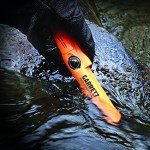
Pinpointer metal detectors are among some of the more useful tools to help you search for buried treasure. Pinpointers are small, handheld metal detectors that help you pinpoint the precise location of your target. They cut down the time that you spend digging for treasure, allowing you to cover more ground. Do you know what to look for in a pinpointer metal detector?
Waterproof or Not?
There are many different features to consider when looking for a pinpointer metal detector. If you plan to use your pinpointer underwater, you’ll want to go for a completely waterproof model. Some pinpointers are water resistant and can be used in light to moderate rain, and others can’t be exposed to any water at all.
Color
Color is another thing to consider. The most common colours for pinpointers are your standard black, white and grey. Some models come in bright colours to help with visibility. This is especially handy if you plan to use it underwater — you don’t want to lose sight of your pinpointer if it slips out of your hand.
Pinpointer Signal Alert
Pinpointers also have different ways of signalling that they have detected a target. Some models emit only an audio signal, and others also vibrate or give off a light signal. Many pinpointers allow you to attach headphones so that you can hear the audio signal better.
Pinpointers Are Lightweight
Pinpointers are small and lightweight, and are designed to be easy to use. Some pinpointers, such as the Garrett Pro-Pointer AT, have only one button that you use to control all of its settings. Other models have plenty of buttons and switches.
Price Points
The last thing to consider is price. Pinpointers generally range from around $50 to $200. Consider your budget, and think about the features that are most important for you to have. You can find some great budget options on the lower end of the price spectrum, or you can shell out for a rugged, heavy-duty model.
What is the best Metal Detector for pinpointing?

A common question we get asked is what is the best metal detector for pinpointing? These are handy little units to keep in your kit whether a beginner or an experienced hunter. There are plenty of great pinpointing units out there. If you’re looking for quality, reliability and versatility, the Garrett Pro-Pointer AT is the pinpointer to go with.
‘AT’ stands for all terrain — the Garrett Pro-Pointer is fully waterproof up to 10 feet underwater. This means that you can search lakes, rivers and oceans for buried treasure. The fact that it’s waterproof also means that you can run it under the tap to clean it off when you get home.
Another great feature of the Garrett Pro-Pointer is the fast retune function. With the press of a button, the fast retune feature allows you to narrow the field of detection.
This model is sleek and easy to handle. It can also be paired with wireless headphones to alert you when an object is located.
Other great pinpointing metal detectors are the PinPointer by Bounty Hunter, the Garrett Pro-Pointer Edge Digger, the Deteknix XPointer, the Makro Waterproof Pinpointer and the Red Fisher F-Pulse Waterproof Pinpointer. These are 10 good choices for reliable pinpointers.
Do you need a metal detector for pinpointing?

While it’s certainly possible to find treasure using only a traditional metal detector, a pinpointer will make your life a whole lot easier.
Traditional metal detectors can tell you the rough area where an item is located, but metal detector pinpointers are capable of giving you a more precise location.
Pinpointers help to drastically cut the time you spend looking by telling you exactly where to look. They cut down on digging time and save you energy, allowing you to cover more ground faster. You can also dig small holes, which can be easily filled in when you’re finished.
Pinpointers also help to prevent you from damaging an item by accidentally digging over it. Pinpointer metal detectors are especially useful in rocky areas, or in locations with plenty of roots.
How do you use a pinpointer for metal detecting?
After your metal detector picks something up, you’ll need to use your pinpointer to locate the exact spot of your treasure.
First, use a big metal detector to find the general location of the target. Dig a hole, and then use the pinpointer to narrow down your search area.
One point in what to look for in a pinpointer metal detector is the alert sound. How sharp is your hearing? Some pinpointers may not be suitable if your hearing isn’t as sharp as it used to be…
Like any other metal detector, pinpointers make noise or vibrate when they pick something up. Scan the hole with your pinpointer until the beeps get faster and closer together. When the beeps become one continuous sound, this means that you are within ½ ‘’ of your item.
What is a pinpoint on a metal detector?
It’s a good question – what is a pinpoint on a metal detector?
A pinpointer is a handheld device that is used to help you zero in on the precise location of your target object. Pinpointers are small and lightweight, and they run on battery power.
Just like larger metal detectors, pinpointers work by transmitting an electromagnetic field to detect the presence of metal nearby.
Some pinpointers are built into standard metal detectors. When you push a button, the metal detector will switch to pinpointer mode. The benefit of handheld pinpointers is that the search coil is smaller, allowing them to zero in on the target’s location.
Pinpointers are designed to be used in conjunction with a metal detector. Use the metal detector to find the general location of the target. One you have dug a hole, use the pinpointer to zero in on the exact location of the item.
Most pinpointers have an On/ Off switch. To double check how to turn on your pinpointer, refer to your instruction manual.
How do you use the Garrett Pro Pointer?

The Garrett Pro-Pointer only has only one button. To turn the Pro-Pointer on, press and hold the button while keeping the detector away from anything metallic. Two beeps will sound and the LED will light up, showing you that the detector is on.
Begin by adjusting the settings. The Garrett Pro-Pointer gives you the option to adjust the sensitivity depending on the terrain. Lower sensitivity is best for highly mineralized areas. You can also set the audio settings to either Audio-plus-Vibrate or Vibrate-only.
To detect large targets, slowly scan the detector until you hear the alarm or vibration. Quickly press the button to retune and narrow the field of detection, and continue to scan until you get to the exact location. Continue to do this until you find your target object.
The scraping blade feature of the Garrett Pro-Pointer is great for sifting through dirt. To use it, pass the blade over a target area until the alarm goes off. The Pro-Pointer’s 360º side-scan feature allows it to scan for metallic objects that come close to the blade.
What tools are needed for metal detecting?
In addition to a pinpointer, there are several other tools you need to get started with metal detecting.
- Metal detector: This one may be obvious, but a pinpointer can only get you so far. A traditional metal detector is able to sweep large areas to give you a general idea of where treasure is located. If you are starting off on learning ropes, a beginners metal detector kit contains the basic tools to get started
- Metal detector headphones: By using headphones, you won’t miss any sounds that your detector emits. Headphones help to tune out background noise, and are especially useful in noisy areas like beaches.
- Shovel: A big or small tool like a garden shovel will let you quickly dig for items that are buried deeply. You can also use a shovel with serrated edges that is made specifically for metal detecting. It’s also a good idea to use a shovel with a small diameter, since this allows you to easily refill the holes that you dig. Here’s a useful discussion on shovel sizes.
- Sand scoop: If you plan to dig in a sandy place like a beach, a sand scoop is a must. Sand scoops help you sift through the sand to find your target item.
- Bag: Once you find your object, you’ll need somewhere to put it. Look for something that closes securely to keep all of your hard-earned treasures safe.
- Spare batteries: You don’t want to be left stranded with a metal detector that’s run out of juice. Bring along some spare batteries, and your future self will thank you.
Can you find gold with a pinpointer?

Can you find gold with a pinpointer? Absolutely. It’s definitely possible to find gold with a pinpointer, if you know where to look. Unlike other metals, natural gold is far less likely to turn up on any given beach.
It’s a good idea to look for gold in places where they have been found before, such as dredge tailing piles and place deposits. Do some research to find regions near you that have produced gold, and take a look around.
Are cheap pinpointers any good?
Most pinpointers cost less than $200, and the cheapest are around $50. Quality varies between brands, but there are some great options on the lower end of the price spectrum.
For a budget-friendly pinpointer, consider the Deteknix X-pointer. Like the Garrett Pro Pointer AT, it comes in a bright orange colour. Unlike the Garrett Pro, the Deteknix is not waterproof.
The Deteknix has adjustable sensitivity settings and a bright LED light. Reviewers say that this metal detector is high-quality and reliable, and gives you a great bang for your buck.
How deep will a pinpointer detect?
Different pinpointers have different depth ranges. The Garrett Pro-Pointer can detect objects at depths up to 10’’.
Generally, pinpointers can easily detect coins at depths of 1-2’’.
What is the best waterproof pinpointer?
The best waterproof pinpointer is the Garrett Pro Pointer AT. The Garrett Pro-Pointer can detect at depths of up to 10 feet underwater, making this pinpointer ideal for underwater hunting. You can also use it during rainstorms and in mud puddles.
Sometimes referred to as the “Garrett Carrot” because of its colour, this pinpointer is bright orange to make sure that it’s visible underwater. If you accidentally let go of it while hunting in a lake, the bright colour will help you locate it.
Knowing What To Look For In A Pinpointer Metal Detector
One of the main reasons in choosing to buy a pinpointer is to save time. By targeting the hidden object, you aren’t spending as much time randomly digging over a broader area. The value of a good pinpointer let’s you hone in on the location of the object, reduce the hole size and uncover the object.
Another benefit of using pinpointers for metal detecting is reducing any damage to the object. Shovels or edge cutters have been known to inadvertently damage the treasure whilst digging enthusiastically.
Quality pinpointers for metal detecting feature advanced audio and vibration options and some even feature LED lighting to see better. Some are waterproof, so choose the unit carefully and check to make sure it is waterproof if you are intending to go treasure hunting in rivers, lakes or the sea.
There are a lot of pinpointers on the market. This is why it’s important to know what to look for in a pinpointer metal detector!
Related Posts
 3 Best Metal Detecting Pinpointers For Fast Targeting
3 Best Metal Detecting Pinpointers For Fast Targeting Pinpointer Metal Detector Accuracy: The Top 10 Pinpointers
Pinpointer Metal Detector Accuracy: The Top 10 Pinpointers Becoming A Gold Panner – 4 Things You Will Find Useful
Becoming A Gold Panner – 4 Things You Will Find Useful When To Go Gold Panning? 5 Most ‘Lucrative’ Times Of The Year
When To Go Gold Panning? 5 Most ‘Lucrative’ Times Of The Year What Are The Different Types Of Metal Detecting Search Coils? Beginners Guide
What Are The Different Types Of Metal Detecting Search Coils? Beginners Guide What To Look For In A Beach Metal Detector For Beach Detecting
What To Look For In A Beach Metal Detector For Beach Detecting
No related posts.
